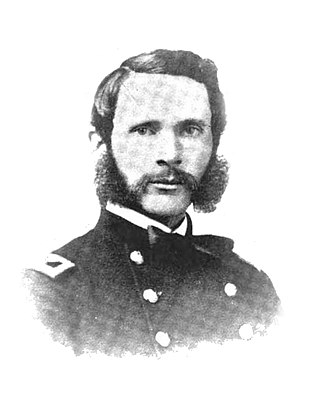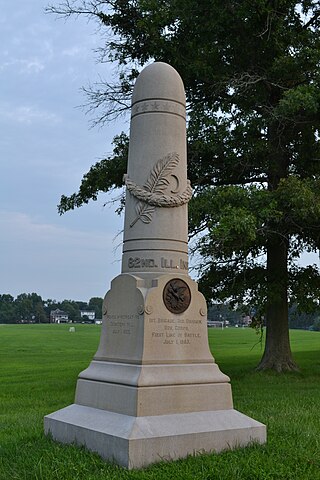
Patrick Henry O'Rorke or O'Rourke was an Irish-American immigrant who became a colonel in the Union Army during the American Civil War and was killed at the Battle of Gettysburg.

The 2nd Wisconsin Infantry Regiment was an infantry regiment that served in the Union Army during the American Civil War. It spent most of the war as a member of the famous Iron Brigade of the Army of the Potomac. It suffered the largest number of casualties as a percentage of its total enlistment of any Union Army unit in the war.
The 7th Wisconsin Infantry Regiment was an infantry regiment that served in the Union Army during the American Civil War. It was a component of the famous Iron Brigade in the Army of the Potomac throughout the war.

The 6th Wisconsin Infantry Regiment was an infantry regiment that served in the Union Army during the American Civil War. It spent most of the war as a part of the famous Iron Brigade in the Army of the Potomac.

The 82nd Regiment Illinois Volunteer Infantry, known as the "2nd Hecker Regiment," was an infantry regiment that served in the Union Army during the American Civil War. It was one of the three "German" regiments furnished to the Union by Illinois. Approximately two-thirds of its members were German immigrants and most of the other third was composed of immigrants from various countries. Company C was almost entirely Jewish, and Company I all Scandinavians.

The 5th Michigan Infantry Regiment was an infantry regiment from Michigan that served in the Union Army during the American Civil War. The regiment was mustered into federal service in August 1861 and served in the Eastern Theater. It fought in all the major battles of the Army of the Potomac, including Seven Pines, the Seven Days Battles, Second Bull Run, Chantilly, Antietam, Fredericksburg, Chancellorsville, Gettysburg, the Wilderness, Spotsylvania, Cold Harbor, Petersburg, and Appomattox. The regiment was mustered out in June 1865.

The 59th New York Infantry Regiment was a regiment in the Union Army during the American Civil War. As part of the Second Corps of the Army of the Potomac, it played a significant role in battles such as Antietam and Gettysburg.

The 44th New York Infantry Regiment was a regiment of the Union Army during the American Civil War which was formed up in mid-1861, and mustered in on August 30, 1861. The regiment wore an americanized zouave uniform which consisted of a dark blue zouave jacket with red piping on the cuffs, dark blue trousers with a red stripe, a red zouave shirt, a dark blue forage cap, and a pair of leather gaiters. The jacket had buttons down the front of it which was not part of the original French zouave uniform.

The 125th New York Infantry Regiment was a volunteer regiment from Rensselaer County, New York, during the American Civil War. Formed during the summer of 1862, the unit was officially mustered into United States Service on 27–29 August 1862, by Col. George L. Willard. He had seen previous service in the Mexican War as well. Levin Crandall was commissioned lieutenant colonel, and James C. Bush major. The unit was mustered out on 5 June 1865.

The 67th New York Infantry Regiment was a regiment of the Union Army, which was raised in the city of Brooklyn in 1861 at the beginning of the American Civil War.

The 45th New York Infantry Regiment, also known as the 5th German Rifles, was an infantry regiment that served in the Union Army during the American Civil War. It was composed almost entirely of German immigrants. Formed approximately five months after the start of hostilities, the unit's service spanned almost the entirety of the war, and it saw action in several of the war's noteworthy battles, in both the Eastern and Western Theaters.

The 61st New York Infantry Regiment, also known as the "Astor Regiment", was an infantry regiment of the Union Army during the American Civil War.

The 6th Regiment New York Heavy Artillery, U.S. Volunteers, the "Anthony Wayne Guard", was an artillery regiment of the Union Army during the American Civil War. It was originally mustered in as the 135th New York Volunteer Infantry Regiment, and served as both artillery and infantry.

The 80th New York Infantry Regiment, originally designated the 20th New York State Militia Regiment, "Ulster Guard", was an infantry regiment of the Union Army during the American Civil War.

The 83rd New York Infantry Regiment, the "Ninth Militia," "Ninth Infantry National Guard," or "City Guard", was an infantry regiment of the Union Army during the American Civil War.

The 126th New York Infantry Regiment was an infantry regiment in the Union Army during the American Civil War.

The 66th New York Infantry Regiment was an infantry regiment in the Union Army during the American Civil War.

The 108th New York Infantry Regiment was an infantry regiment in the Union Army during the American Civil War.

The 76th New York Infantry Regiment was an infantry regiment in the Union Army during the American Civil War.

The 13th New York Infantry Regiment was an infantry regiment in the Union Army during the American Civil War.







